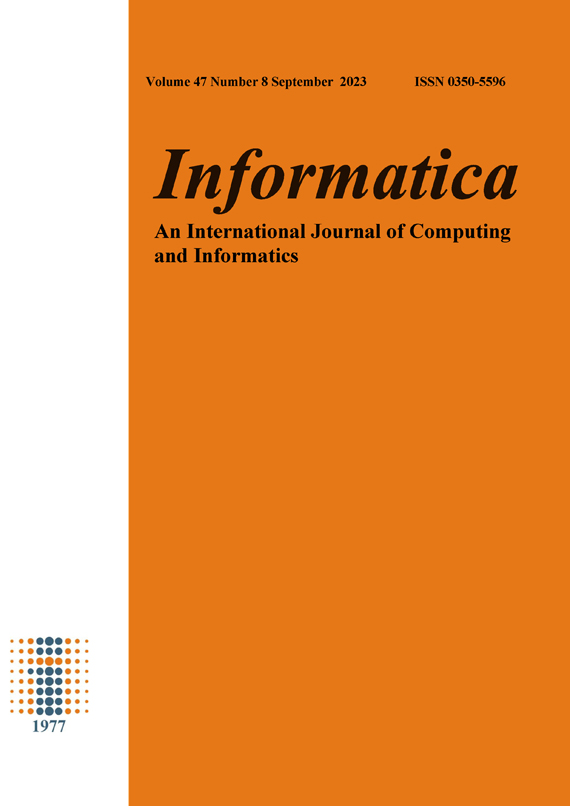A New Divergence Measure for Intuitionistic Fuzzy Matrices
DOI:
https://doi.org/10.31449/inf.v47i8.3638Abstract
Data available in the real world may not be in a crisp format. Intuitionistic fuzzy matrices are applicable in uncertainty and useful in decision making, relational equation, clustering, etc. Divergence or similarity measures help to characterize dissimilarity or similarity between any two sets. This paper presents a new divergence measure for intuitionistic fuzzy matrices with the verification of its validity. The fundamental properties are demonstrated for the new intuitionistic fuzzy divergence measure. A technique to solve multi-criteria decision-making problems is developed by utilizing the proposed intuitionistic fuzzy divergence measure. Finally, application in the medical diagnosis of this intuitionistic fuzzy divergence measure to decision making is shown using real data.
References
Atanassov K.T.(1986), Intuitionistic fuzzy sets, Fuzzy Sets and Systems, vol.20, no.1, pp.87–96.
Bhandari D. & Pal N.R. (1993), Some new information measure for fuzzy sets, Information Sciences, vol.67, no.3, pp.209–228.
De Luca, A., Termini, S. (1972), A definition of a non-probabilistic entropy in the setting of fuzzy sets theory. Inform. and Control 20, 301–312.
Fan J, Xie W: Distance measures and induced fuzzy entropy. Fuzzy Sets Syst. 1999, 104(2):305–314. 10.1016/S0165-0114(99)80011-6
Hung, W.L. and Yang, M.S. (2008), On the J- divergence of Intuitionistic fuzzy sets with its applications to pattern recognization, Information science, 178, 1641 -1650.
Kullback S. & Leibler R.A. (1951), On information and sufficiency, The Annals of Mathematical Statistics, vol.22, no.1, pp.79–86.
Li D. & Cheng C. (2002), New similarity measure of intuitionistic fuzzy sets and application to pattern recognitions, Pattern Recognition Letters, vol.23, nos.1-3, pp.221–225.
Mishra, A.R., Singh, R.K. & Motwani, D. (2020), Intuitionistic fuzzy divergence measure-based ELECTRE method for performance of cellular mobile telephone service providers. Neural Comput & Applic 32, 3901–3921. https://doi.org/10.1007/s00521-018-3716-6
Mitchell H.B. (2003), On the Dengfeng-Chuntian similarity measure and its application to pattern recognition, Pattern Recognition Letters, vol.24, no.16, pp. 3101–3104.
Montes S, Couso I, Gil P, Bertoluzza C (2002) Divergence measure between fuzzy sets. Int J Approx Reason 30(2):91–105.
Pal M., Khan S., & Shyamal A. K. (2002), Notes on Intuitionistic Fuzzy Sets 8, 51.
Radhika R. & Subramanian S. (2018), An application of intuitionistic fuzzy soft matrix theory based on the reference function in decision making problem, International Journal of Pure and Applied Mathematics, vol. 119, No.6,219-234.
Szmidt E., & Kacprzyk J. (2001), Intuitionistic fuzzy sets in intelligent data analysis for medical diagnosis, Lecture Notes in Computer Science, vol.2074, pp. 263–271.
Shang X., & JiangG. (1997), A note on fuzzy information measures, Pattern Recognition, vol.18, no.5, pp.425–432.
Shannon C.E. (1948), A mathematical theory of communication, Bell System Technical Journal, vol.27, pp.379–423, 623–656.
Szmidt E., & KacprzykJ. (1997), On measuring distances between intuitionistic fuzzy sets, Notes on Intuitionistic Fuzzy Sets, vol.3, no.4, pp.1–13.
Szmidt, E., and J. Kacprzyk (2000), Distances between intuitionistic fuzzy sets, Fuzzy Sets and Systems, vol.114, no.3, pp.505–518.
Verma, R., Maheshwari, S. A new measure of divergence with its application to multi-criteria decision making under fuzzy environment. Neural Comput & Applic 28, 2335–2350 (2017). https://doi.org/10.1007/s00521-016-2311-y
Vlachos I.K. & Sergiadis G.D. (2007), Intuitionistic fuzzy information- application to pattern recognition, Pattern Recognition Letters, vol.28, no.2, pp.197–206.
Wei P., &Ye, J. (2010), Improved intuitionistic fuzzy cross-entropy and its application to pattern recognitions, International Conference on Intelligent Systems and Knowledge Engineering, pp.114–116.
Wei C.P., Wang P., & Zhang Y.Z.(2011), Entropy, similarity measure of interval-valued intuitionistic fuzzy sets and their applications, Information Sciences, vol.181, no.19, pp.4273–4286.
Wu J.Z., & Zhang Q. (2011), Multi-criteria decision-making method based on intuitionistic fuzzy weighted entropy, Expert Systems with Applications, vol.38, no.1, pp.916–922.
Yue Z, & Jia Y., (2017), A projection-based approach to intuitionistic fuzzy group decision making. Sci Iran Trans E Ind Eng 24(3):1505–1518
Zadeh L.A., Fuzzy sets, Information and Control, vol.8, no.3, pp.338–353, 1965.
Zhang, Q. S & Jiang, S.Y. (2008), A note on information entropy measures for vague sets and its applications, Information Sciences, 178, 4184-4191.
Downloads
Published
Issue
Section
License
I assign to Informatica, An International Journal of Computing and Informatics ("Journal") the copyright in the manuscript identified above and any additional material (figures, tables, illustrations, software or other information intended for publication) submitted as part of or as a supplement to the manuscript ("Paper") in all forms and media throughout the world, in all languages, for the full term of copyright, effective when and if the article is accepted for publication. This transfer includes the right to reproduce and/or to distribute the Paper to other journals or digital libraries in electronic and online forms and systems.
I understand that I retain the rights to use the pre-prints, off-prints, accepted manuscript and published journal Paper for personal use, scholarly purposes and internal institutional use.
In certain cases, I can ask for retaining the publishing rights of the Paper. The Journal can permit or deny the request for publishing rights, to which I fully agree.
I declare that the submitted Paper is original, has been written by the stated authors and has not been published elsewhere nor is currently being considered for publication by any other journal and will not be submitted for such review while under review by this Journal. The Paper contains no material that violates proprietary rights of any other person or entity. I have obtained written permission from copyright owners for any excerpts from copyrighted works that are included and have credited the sources in my article. I have informed the co-author(s) of the terms of this publishing agreement.
Copyright © Slovenian Society Informatika








